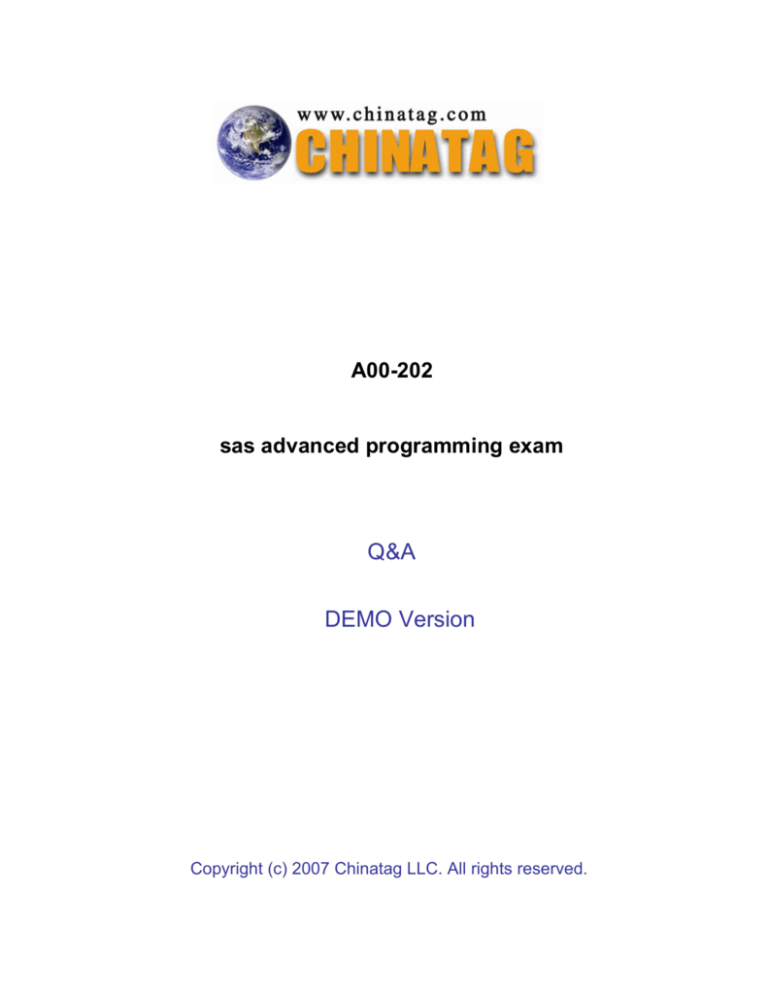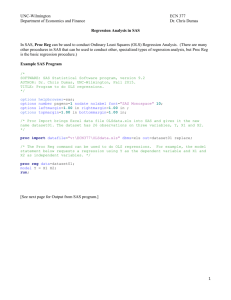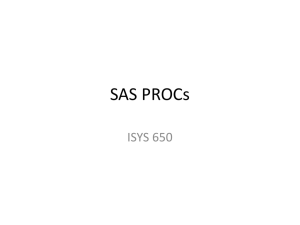
A00-202
sas advanced programming exam
Q&A
DEMO Version
Copyright (c) 2007 Chinatag LLC. All rights reserved.
Important Note
Please Read Carefully
For demonstration purpose only, this free version Chinatag study guide contains 10 full length questions selected
from our full version products which have more than 200 questions each.
This Study guide has been carefully written and compiled by Chinatag certification experts. It is designed to help you
learn the concepts behind the questions rather than be a strict memorization tool. Repeated readings will increase
your comprehension.
For promotion purposes, all PDF files are not encrypted. Feel free to distribute copies among your friends and let
them know Chinatag website.
Study Tips
This product will provide you questions and answers along with detailed explanations carefully compiled and written
by our experts. Try to understand the concepts behind the questions instead of cramming the questions. Go through
the entire document at least twice so that you make sure that you are not missing anything.
Latest Version
We are constantly reviewing our products. New material is added and old material is revised. Free updates are
available for 90 days after the purchase. You should check the products page on the http://www.chinatag.com
website for an update 3-4 days before the scheduled exam date.
Please tell us what you think of our products. We appreciate both positive and critical comments as your feedback
helps us improve future versions. Feedback on specific questions should be send to feedback@chinatag.com.
Thanks for purchasing our products and look forward to supplying you with all your Certification training needs.
Good studying!
Technical and Support Team
Chinatag LLC.
Leading the way in IT testing and certification tools, www.chinatag.com
-2-
A00-202
Question No: 1 Which of the following statement(s) in the DATASETS procedure alters the name of a SAS
data set stored in a SAS data library?
A. RENAME statement only
B. CHANGE statement only
C. MODIFY and RENAME statements
D. MODIFY and CHANGE statements
Answer: B
Question No: 2 The following SAS program is submitted:
<insert statement here>; %let
development = ontime; proc print
data = sasuser.highway;
title "For &dept"; title2 "This project was completed
&development"; run;
Which one of the following statements completes the above and resolves title1 to "For
research&development"?
A. %let dept = %str(research&development);
B. %let dept = %str(research%&development);
C. %let dept = %nrstr(research&development);
D. %let dept = %nrstr(research%&development);
Answer: C
Question No: 3 Which one of the following options controls the pagesize of a SAS data set?
A. SIZE=
B. BUFNO=
C. BUFSIZE=
D. PAGESIZE=
Answer: C
Question No: 4 Given the following SAS data set ONE:
3
A00-202
ONE REP
COST
SMITH 200
SMITH 400
JONES 100
SMITH 600
JONES 100
JONES 200
JONES 400
SMITH 800
JONES 100
JONES 300
The following SAS program is submitted:
proc sql;
select rep, avg(cost) as AVERAGE
from one
group by rep
having avg(cost) > (select avg(cost) from one); quit;
Which one of the following reports is generated?
A. REP AVERAGE
JONES 200
B. REP AVERAGE
JONES 320
C. REP AVERAGE
SMITH 320
D. REP AVERAGE
SMITH 500
Answer: D
Question No: 5 The following SAS program is submitted:
4
A00-202
proc sort data = sales tagsort;
by month year; run;
Which of the following resource(s) is the TAGSORT option reducing?
A. I/O usage only
B. CPU usage only
C. I/O and CPU usage
D. temporary disk usage
Answer: D
Question No: 6 The following SAS program is submitted:
data one;
do i = 1 to 10; ptobs = ceil(ranuni(0)
* totobs); set temp point = ptobs
nobs = totobs;
output;
end; stop;
run;
The SAS data set TEMP contains 2,500,000 observations. Which one of the following represents the
possible values for PTOBS?
A. any integer between 1 and 10
B. any real number between 0 and 1
C. any integer between 1 and 2,500,000
D. any real number between 1 and 2,500,000
Answer: C
Question No: 7 Which one of the following programs contains a syntax error?
A. proc sql; select product.*, cost.unitcost,
sales.quantity from product p, cost c, sales s
where p.item = c.item and p.item = s.item;
quit;
5
A00-202
B. proc sql; select product.*, cost.unitcost,
sales.quantity from product, cost, sales where
product.item = cost.item and product.item =
sales.item; quit;
C. proc sql; select p.*, c.unitcost,
s.quantity from product as p, cost as c,
sales as s where p.item = c.item and
p.item = s.item; quit;
D. proc sql; select p.*, c.unitcost,
s.quantity from product, cost, sales
where product.item = cost.item and
product.item = sales.item; quit;
Answer: D
Question No: 8 The following SAS code is submitted:
%macro houses(dsn = houses,sub = RANCH);
data &dsn; set
sasuser.houses; if style =
"&sub";
run; %mend; %houses(sub =
SPLIT) %houses(dsn = ranch)
%houses(sub = TWOSTORY)
Which one of the following is the value of the automatic macro variable SYSLAST?
A. work.ranch
B. work.houses
C. WORK.RANCH
D. WORK.HOUSES
6
A00-202
Answer: D
Question No: 9 Given the following SAS data sets ONE and TWO:
ONE TWO NUM COUNTRY NUM
CITY
1 CANADA 3 BERLIN 2 FRANCE 5
TOKYO 3 GERMANY 4 BELGIUM 5
JAPAN
The following SAS program is submitted:
proc sql;
select country
from one
where not exists
(select * from two where one.num =
two.num); quit;
Which one of the following reports is generated?
A. COUNTRY
GERMANY
JAPAN
B. COUNTRY
FRANCE
BELGIUM
C. COUNTRY
CANADA
FRANCE
BELGIUM
D. COUNTRY
CANADA
FRANCE
GERMANY
7
A00-202
Answer: C
Question No: 10 Which one of the following statements is true?
A. The WHERE statement can be executed conditionally as part of an IF statement.
B. The WHERE statement selects observations before they are brought into the PDV.
C. The subsetting IF statement works on observations before they are read into the PDV.
D. The WHERE and subsetting IF statements can be used interchangeably in all SAS programs.
Answer: B
8










